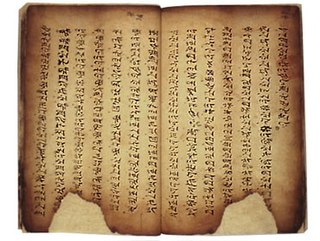The Hmu language, also known as Qiandong Miao, Central Miao, East Hmongic, or Black Miao, is a dialect cluster of Hmongic languages of China. The best studied dialect is that of Yǎnghāo (养蒿) village, Taijiang County, Guizhou Province, China.

The Yi script is an umbrella term for two scripts used to write the Yi languages; Classical Yi, and the later Yi Syllabary. The script is also historically known in Chinese as Cuan Wen or Wei Shu and various other names (夷字、倮語、倮倮文、畢摩文), among them "tadpole writing" (蝌蚪文).
Lisu is a tonal Tibeto-Burman language spoken in Yunnan, northern Burma (Myanmar), and Thailand and a small part of India. Along with Lipo, it is one of two languages of the Lisu people. Lisu has many dialects that originate from the country in which they live. Hua Lisu, Pai Lisu, and Lu Shi Lisu dialects are spoken in China. Although they are mutually intelligible, some have many more loan words from other languages than others.
The She language, autonym Ho Ne or Ho Nte, is an endangered Hmong–Mien language spoken by the She people. Most of the over 709,000 She people today speak Hakka Chinese. Those who still speak She—approximately 1,200 individuals in Guangdong province—call themselves Ho Ne "mountain people". She is nearly extinct today.
Tai Nuea is one of the languages spoken by the Dai people in China, especially in the Dehong Dai and Jingpo Autonomous Prefecture in the southwest of Yunnan province. It is closely related to the other Tai languages. Speakers of this language across the border in Myanmar are known as Shan. It should not be confused with Tai Lü. There are also Tai Nuea speakers in Thailand.
The Kam language, also known as Gam, or in Chinese, Dong or Tung-Chia, is a Kam–Sui language spoken by the Dong people. Ethnologue distinguishes three Kam varieties as separate but closely related languages.
The SASM/GNC/SRC romanization of Tibetan, commonly known as Tibetan pinyin, is the official transcription system for the Tibetan language in the People's Republic of China for personal names and place names. It is based on the Lhasa dialect of Standard Tibetan and reflects the pronunciation except that it does not mark tone. It is used within China as an alternative to the Wylie transliteration for writing Tibetan in the Latin script within academic circles; Wylie transliteration is more commonly used.
The Hani language is a language of the Loloish (Yi) branch of the Tibeto-Burman linguistic group spoken in China, Laos, and Vietnam by the Hani people.

The Hmongic also known as Miao languages include the various languages spoken by the Miao people, Pa-Hng, and the "Bunu" languages used by non-Mien-speaking Yao people.

The Proto-Hmong–Mien language is the reconstructed ancestor of the Hmong–Mien languages.
Bu-Nao, or Bunu proper, is a Hmongic (Miao) dialect cluster spoken in Guangxi, Yunnan, and Guizhou in China. Its speakers are among the Bunu : ethnic Yao (Mien) speakers of Miao languages.

Standard Zhuang is the official standardized form of the Zhuang languages, which are a branch of the Northern Tai languages. Its pronunciation is based on that of the Yongbei Zhuang dialect of Shuangqiao, Guangxi in Wuming District, Guangxi with some influence from Fuliang, also in Wuming District, while its vocabulary is based mainly on northern dialects. The official standard covers both spoken and written Zhuang. It is the national standard of the Zhuang languages, though in Yunnan a local standard is used.
The Xong language, is the northern-most Hmongic language, spoken in south-central China by ca 0.9 million people. It's called Xiangxi Miaoyu (湘西苗语), Western Hunan Miao, in Chinese. In Western sources, it's been called Eastern Miao, Meo, Red Miao and North Hmongic. The official alphabet was adopted in 1956.
The A-Hmao language, also known as Large Flowery Miao or Northeast Yunnan Miao, is a Hmongic language spoken in China. It is the language the Pollard script was designed for, and displays extensive tone sandhi. There is a high degree of literacy in Pollard among the older generation.
The West Hmongic languages, also known as Chuanqiandian Miao and Western Miao, is the major branch of the Hmongic languages of China and Southeast Asia.
Luobohe Miao, a.k.a. Hmjo or A-Hmyo, is a Miao language of China.
Guiyang Miao, also known as Guiyang Hmong, is a Miao language of China. It is named after Guiyang County, Guizhou, though not all varieties are spoken there. The endonym is Hmong, a name it shares with the Hmong language.
Pingtang Miao, named after Pingtang County in which it is spoken, is a group of Miao language varieties of China.
Raojia is a Hmongic language spoken by about 5,000 people in 3 villages of Heba Township 河坝乡, Majiang County, Guizhou.
Shehua is an unclassified Sinitic language spoken by the She people of southeastern China. It is also called Shanha 山哈 (San-hak) or Shanhahua 山哈话. Shehua speakers are located mainly in Fujian and Zhejiang provinces of southeastern China, with smaller numbers of speakers in a few locations of Jiangxi, Guangdong, and Anhui provinces.



